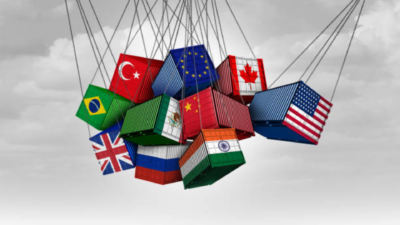An economically reforming China offers fresh investment opportunities
No matter how the White House spins last week’s decision that saw China and the US roll-back tariffs on each other’s goods for an initial 90-day period, the fact is the US blinked.
That geopolitical reality might have been obscured in the markets’ euphoria over the de-escalation of a lose-lose trade war between the world’s two largest economies, but there can be no mistaking the different language emanating from Washington compared with the triumphalism that accompanied “Liberation Day” on April 2.
But when Trump backed away from this draconian policy just a week later, announcing a 90-day pause on the reciprocal tariffs and lowering the rate to 10 per cent for most countries, he specifically excluded China. Instead, its tariff rate was raised to 125 per cent, due, in Trump’s words, to China’s “lack of respect” for the world’s markets.
Three weeks later, the language emanating from the China-US trade talks was far different, with the joint statement lauding “the importance of a sustainable, long-term, and mutually beneficial economic and trade relationship”. A “lack of respect” has transformed into “mutually beneficial”.
For Australia, economically joined at the hip to China, it was a positive outcome – and not just because of the export numbers. No, the long-term benefit will come if it forces a reassessment of how the Chinese economy is evolving and the investment opportunities that will offer, especially for institutional investors, and acknowledging that Trump’s “America first” vision – despite all its policy gyrations – is fundamentally rewriting the economic rulebook.
To paraphrase Investor Strategy News’ contributor Rob Prugue, for years, monetary and fiscal policy moved in relative sync. That gave investors predictability. No more. Now it’s contradictions: protectionism, immigration crackdowns, fiscal austerity that would make Scrooge blush and tax cuts skewed to asset owners. Policy has moved – and rattled – markets. This isn’t just another news cycle. It’s shifting the cycle.
There seems little practical value in trying to second-guess a Trump administration – with tariffs being an obvious case in point. But with a China, that’s a luxury we can’t afford – tasseography (tea-leaf reading) is an imperative.
In this vein, it’s worth noting that China’s leadership had changed economic course before the advent of Trump 2.0. Consumer spending is finally being encouraged, social security services expanded, along with less dependence on exports (remember, the US takes less than 15 per cent of its total exports), a breakthrough in AI technology, a stabilising property market, and, most significantly, a more benign government attitude to business.
Income Partners, a fixed-interest asset manager with an Asian focus, puts it up succinctly, arguing Beijing is increasingly taking a “pragmatic approach” to the business community and the economy.
In a letter to investors, Income Partners’ Emil Nguy, chairman, CIO and CEO, said: “President Xi Jinping recently held a summit with tech entrepreneurs in China and has pushed for economic expansion and tech innovation. The Chinese authorities have also introduced fresh measures to revive domestic consumption and retail sales have increased 3.8 per cent in the first two months of 2025. This has fuelled optimism that Chinese stocks and bonds will continue their advances this year.”
Chinese equities back in favour
Certainly, equities are responding, with the MSCI China index up 15 per cent since the beginning of the year – a market response that’s not surprising Brian Arcese, an equity analyst with the global asset manager Foord, who oversees its Global Equity Fund that’s currently strategically placed by being overweight Western Europe and Asia-Pacific and underweight North America.
He concurs with Nguy’s assessment of China’s economic reforms and how this is fuelling demand, adding that Chinese equites are “inexpensive”, not only relative to global equities but also relative to their own history.
“So, the starting point has been quite low. Add to that the fact that corporate earnings have kept coming, and now the impact of the tariffs will probably be lower than what was originally expected. I think investors have decided the discount they’re paying for these companies makes it worth the risk.”
Arcese stresses that this “reform” momentum began during the Biden administration, when cross-border restrictions on AI software and chip technology, with China clearly top of mind, were imposed, invariably triggering a policy response from Beijing.
“If you have an external force, in this case, the US – I’m not trying to over-dramatise this – trying to cut-off a country from technology, then you’ll get a reaction. Remember, what you have in China is a lot of capital and brain power. So, you don’t cut them off from the market. You just make them find alternatives, of which DeepSeek (a Chinese AI start-up) is an obvious example.”
That’s the political, corporate and market responses. The changes on the social security and consumer fronts are just as dramatic, as Income Partners’ Nguy explains.
“Targeted consumer support policies are being rolled-out, including a Special Action Plan focusing on improving income and social security, supporting key consumption categories, and easing purchase restrictions.
“Recent data indicates a marginal improvement in retail sales growth. This is a necessary transition towards an economy driven by higher-value manufacturing, technological innovation and sustainable consumption.”
The other major impediment to investor sentiment has been a depressed property market, but mounting evidence suggests China has dodged a bullet, with Nguy saying that while contracted sales remain below peak levels, they have stabilised.
“Increased secondary home sales in Tier-1 cities is a positive sign of improving buyer sentiment. Market consensus anticipates relatively flat sales for the current year. The risk of widespread defaults among major developers has significantly receded due to proactive policy interventions,” he says.
In late 2020, the Chinese embassy in Canberra released its “14 grievances” with Australia, accusing it of “poisoning bilateral relations”. It’s been a long and rocky road back from that nadir, but it has happened. Now China is evolving again, proffering the opportunity to participate in this fresh bout of economic reform.
While acknowledging the profound geopolitical differences between Beijing and Canberra that will never disappear, the question remains: within this parameter, do we have the maturity to seize what investment opportunities this offers? In the world of Trump, it’s imperative we do so.











